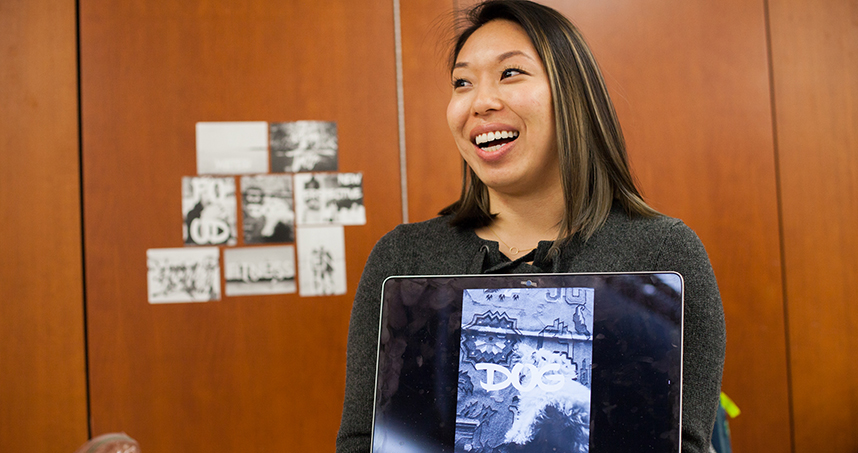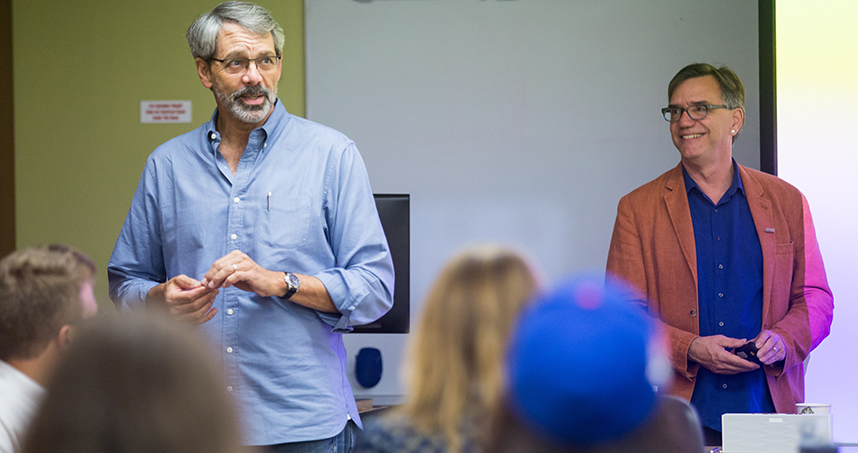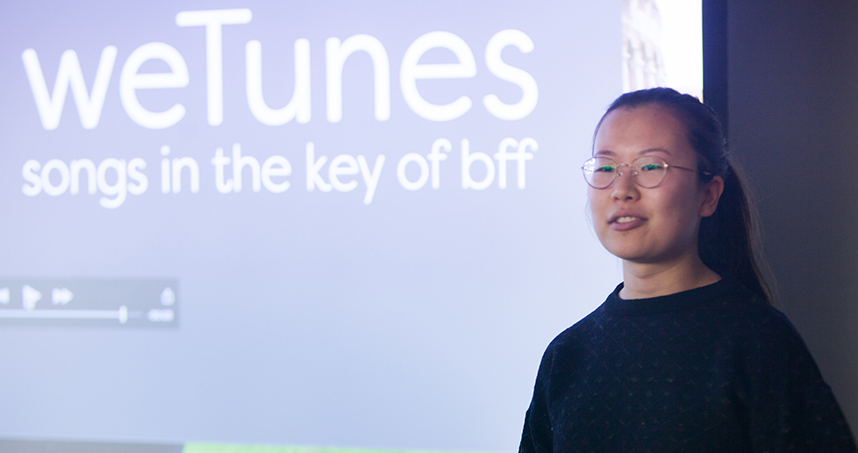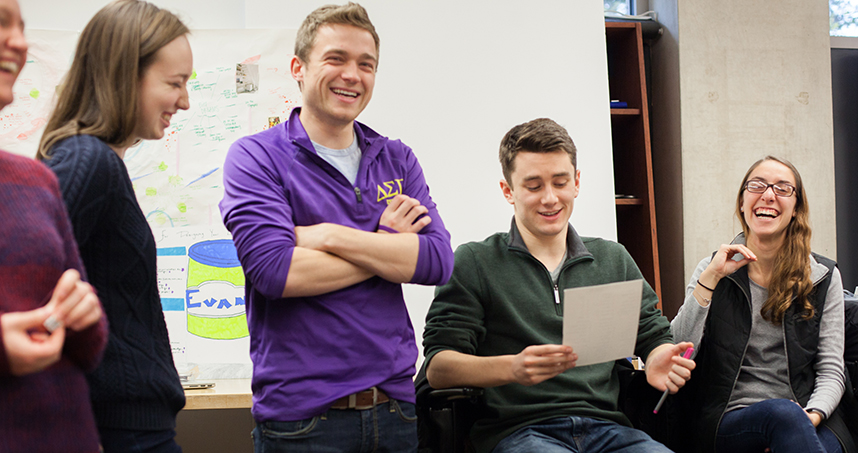Life by Design
“Designing Your Life” course teaches students how to apply design thinking to life
After graduation, Northwestern Engineering senior Angela Hosbein will work at ITW as a product development engineer. But just because she has already accepted a job at the global manufacturing company does not mean she knows how her life will look after June.
“I have a vision of what work will look like, which is great to have,” said Hosbein, who is majoring in mechanical engineering. “But I’m nervous about all the stuff outside of work. How will I make friends outside of school? What activities should I be involved in? Where will I live?”
Although Northwestern students usually feel the most pressure during their job searches, finding a job is just one piece of the puzzle. A new class offered by the Segal Design Institute helps students put the rest of the puzzle together in a way that results in a happy and fulfilling life. Called “Designing Your Life,” the course gives students experience in approaching their lives as a series of design projects.
Hosbein was among the 27 undergraduate students who took the elective course this fall. “I think a lot of students think that finding a job will make them happy,” she said. “But they possibly don’t think beyond that.”
Life Project
“I feel that one of things that students need to do in college is establish who they are — not just what they do.” — Bruce Ankenman Taught at Northwestern for the first time this year, “Designing Your Life” was inspired by a class by the same name at Stanford University. Through seminar-style discussions, role-playing games, writing assignments, guest speakers, and individual mentoring and coaching, the class teaches students to use design thinking to explore bigger life obstacles, such as finding careers they love and designing a fulfilling life.
After Julio M. Ottino, dean of the McCormick School of Engineering, learned about Stanford’s course, he lobbied to bring it to Northwestern. Bruce Ankenman, co-director of the Segal Design Institute and professor of industrial engineering and management sciences, and Pam Daniels, Segal’s design innovator in residence and clinical assistant professor, developed Northwestern’s version of the course.
“I feel that one of things that students need to do in college is establish who they are,” Ankenman said, “not just what they do.”
Stanford Model
Stanford Professors Dave Evans and Bill Burnett in 2008 launched the course in 2008 because as Burnett put it, “both of us didn’t like the advice we got in college.” Although the pair originally envisioned the course as a way to help their product design students “find jobs,” the class evolved into helping students design the life they want. Now “Designing Your Life” is one of Stanford’s most popular electives and has even turned into a New York Times-bestselling book called Designing Your Life: How to Build a Well-Lived, Joyful Life (Knopf Doubleday 2016).
“Life isn’t something that you can plan or engineer,” said Burnett, who is executive director of Stanford’s design program. “Life is one wild and wonderful adventure. So if you’re trying to invent the future, use a design methodology rather than a planning or engineering methodology. Because you can’t plan your way forward, but you can build your way forward.”
Northwestern’s Take
Northwestern’s course has its own spin. Daniels said that a major difference between the two classes is that Stanford’s version tends to abstract the design aspect and focus on the “thinking” aspect, whereas Northwestern emphasizes a more hands-on component involving fieldwork and prototyping. Northwestern will offer its version again in spring quarter 2017.
“We want our students to get a good grounding in what the design process is through the class,” Daniels said. “We don’t want to use the word ‘design’ loosely but really deeply feel what it means to create with intent and iterate, iterate, iterate.”
In Northwestern’s fall course, nearly every class period included a quick design project, or “design sprint.” Ankenman and Daniels challenged their students to be active in a studio culture and turn their ideas into tangible outcomes. In one exercise, for example, pairs of students brought photos of their 10-year-old selves to class and described to each other who they were at that stage. Then each person designed something that appealed to their partner’s childhood interests.
Got it All Figured Out?
"Wherever you start is exactly where you are, and there’s nothing wrong with you.” — Dave Evans Ankenman and Daniels said that Stanford was a very supportive partner in sharing their playbook on how they teach the course. In fact, Evans and Burnett visited Northwestern’s class after speaking to a large audience from the stage of the Cadillac Palace Theatre during Chicago Ideas Week, a seven-day festival throughout the city during October 17-23. The Stanford duo guest-lectured on a topic called reframing, a powerful design-innovation tool that emphasizes getting the questions right long before exploring the answers.
“What’s the age by which you have to have it all figured out?” Evans asked the students, who quickly called out various ages.
“25!” shouted one student.
“30!” said another.
“22!” suggested a third.
All of the answers were incorrect, according to Evans. “There’s always an age in which the culture tells you that you’re supposed to have it figured out,” he said. “This whole notion that you’re late or that something is wrong with you, all of these things are completely dysfunctional. They don’t work. They’re not good for you. Wherever you start is exactly where you are, and there’s nothing wrong with you.”
Not Falling Behind
Reframing these assumptions made several students experience a wave of relief. Undergraduate Evan Witort, for example, often felt “behind” in Northwestern Engineering’s hyper-competitive environment.
“Freshman year, I felt like everyone was smarter than me,” said Witort, a junior studying industrial engineering. “I remember sitting in engineering class wondering if computer programming was a requirement that I somehow missed. I thought, ‘Why am I the only one who doesn’t know how to code?’ Now I talk to people who admit they felt the same way, but people are afraid to have that conversation.”
“Designing Your Life” has encouraged Witort to throw away the notion that he’s somehow behind and instead rethink what’s possible for his life. In one of the class’s main assignments, Ankenman and Daniels asked students to imagine three possible outcomes for their lives. Witort first jotted down the more expected outcomes: consulting and entrepreneurship.
“And then I thought: what if I started a TV show?” he said. “Sometimes at Northwestern, you suppress your feelings. You just think about everything you need to do to graduate and worry more about what everyone else is doing. The class made me ask, ‘What if I didn’t do that? What if I did something totally different?’ I actually considered what I really want to do — not just what’s expected.”
Taking a Step Back
"I’ve stopped looking for just job titles and am more looking for a place with good people whose values align with mine.”’ — Yoko KohmotoWitort partially attributes his inspiration to reframe his thinking to one of the course’s guest speakers: Verinder Syal, an author, entrepreneur, retired business executive, and adjunct lecturer in Northwestern’s Farley Center for Entrepreneurship and Innovation. Witort said the mentoring that the class provided was invaluable.
“There are so many daunting tasks — the need to find a job and the fear of if I’m doing what’s right for me,” he said. “Verinder convinced me that it’s all doable. I just need to think about it in the right way.”
Yoko Kohmoto, a junior studying music in the Bienen School of Music and communication studies in the School of Communications, can relate to Witort’s feelings. She said it’s easy to get so caught up in school pressures that it’s difficult to reflect on what truly makes her happy. Using design thinking caused Kohmoto to look at her life through a fresh lens.
“The class felt like a step back from the intensity of Northwestern,” she said. “People are always asking about my major, where I’m interning, and what I want to do with my life. I’m trying to step away from those pressures and instead ask myself questions like ‘what do I care about?’ I’ve stopped looking for just job titles and am more looking for a place with good people whose values align with mine.”’
Kohmoto particularly valued the course’s “curiosity conversations,” an activity that challenged students to have casual conversations with others out of sheer curiosity. Kohmoto spoke with a Northwestern graduate student and discussed why she pursued graduate school rather than a career directly after undergraduate school. Witort, meanwhile, talked to a cousin who has traveled extensively, visiting six continents.
“It was nice to just talk about something I was simply curious about,” Kohmoto said. “There was no intention getting anything out of the conversation other than fulfilling my curiosity and exploring something that interested me.”
Down a Deeper Path
For several students in “Designing Your Life,” the class is the only place where they feel they can openly discuss these curiosities as well as their fears, true interests, and different approaches to life. At the beginning of the quarter, students were organized into small groups, in which they remained for the duration of the course. In addition to the class’s regular meeting time, the small groups met for discussions during a lab section. This was often where the deeper, most fruitful conversations took place.
“It wasn’t just small talk,” Hosbein said. “These are relationships that I will continue for a long time. For me, the class didn’t answer all of my questions, but it taught me to at least start asking questions. I think that will lead me down a path that’s deeper. It’s not just about finding a job but figuring out my beliefs.”
According to co-instructor Ankenman, this class outcome was a success.
“It’s important for universities to help students develop values, develop themselves, and become good citizens of the world — not just good cogs in a machine,” he said. “I feel like design is the perfect construction framework under which we can help students think about these issues and say, ‘Why don’t you test out different approaches and see how you feel?’ We don’t tell them what to do. We help them figure out how to do things and how to make good decisions.”






